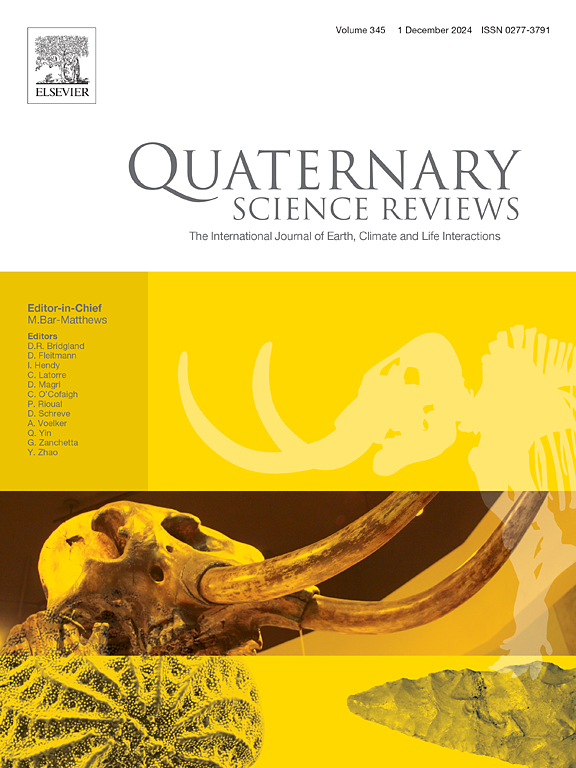论前冰川地区全新世海平面跃层的起源
IF 3.2
1区 地球科学
Q1 GEOGRAPHY, PHYSICAL
引用次数: 0
摘要
在冰川周期中,由于冰川等静力调整(GIA)的作用,冰盖的增大和缩小导致相对海平面(RSL)与全球平均海平面(GMSL)不同,而冰川等静力调整的作用取决于固体地球的粘弹性。在上一个终止期和全新世,与 GIA 有关的等静力隆升导致以前被冰原覆盖的地区 RSL 下降。在这些隆起地区的周围是一个狭窄的陆地带,冰期后 RSL 的下降在全新世期间被一段海平面上升期(即横断期)所打断,在海平面重新下降之前形成了一个高地。挪威、加拿大大西洋沿岸、加拿大太平洋沿岸、斯瓦尔巴群岛、波罗的海和不列颠群岛等许多地方都有全新世横断和高地的详细记录。一个主要的假说认为,当全球海洋水位上升速度超过等静力反弹速度时,就会发生塌陷。我们利用 GIA 模型研究了这些全新世横断面的起源,并检验了另一种假设,即它们主要是固体地球变形的结果。我们的研究结果突显了一种独特的固体地球变形模式,即冰原周围的下沉区域(外围隆起)先向融化的冰块移动,然后远离冰块。我们展示了这种被称为 "反向迁移 "的效应是如何直接由上地幔和下地幔之间的粘度对比造成的。我们将 GIA 模型对 RSL 变化的预测与两个数据集进行了比较:(1)从上一个冰川最大值到现在的 RSL 数据;(2)对挪威和加拿大东部横断面大小的具体限制。与不包含地幔粘度对比的 GIA 预测相比,这两个数据集都更符合 GIA 模型预测的 RSL。我们认为,这对当地的粘度结构是一个有用的约束。此外,这还表明,与传统观点认为全新世横断面记录的 GMSL 暂时超过了等静力抬升不同,固体地球变形,特别是反向迁移在产生近场全新世横断面中发挥了重要作用。本文章由计算机程序翻译,如有差异,请以英文原文为准。
On the origin of Holocene sea-level transgressions in formerly glaciated regions
Over glacial cycles, the growing and shrinking of ice sheets has caused relative sea level (RSL) to differ from global mean sea level (GMSL) due to glacial isostatic adjustment (GIA), which depends on the viscoelastic properties of the solid Earth. During the last termination and through the Holocene, GIA-related isostatic uplift caused RSL to fall in regions formerly covered by ice sheets. Surrounding these uplifting regions is a narrow band of land where postglacial RSL fall was interrupted during the Holocene by a period of sea-level rise (i.e., a transgression) that culminated in a high stand before sea-level fall resumed. Holocene transgressions and high stands have been well documented in many locations including Norway, the Canadian Atlantic coast, the Canadian Pacific coast, Svalbard, the Baltic Sea, and the British Isles. A leading hypothesis poses that transgression occurred when GMSL rise outpaced isostatic rebound. We investigate the origins of these Holocene transgressions using GIA modeling and test the alternative hypothesis that they are predominantly the result of solid Earth deformation. Our results highlight a unique pattern of solid Earth deformation in which the region of subsidence (peripheral bulge) surrounding the ice sheet migrates first towards and then away from the melted ice mass. We show how this effect, which we term ‘reverse migration’, is the direct result of the contrast in viscosity between the upper and lower mantle. We compare our GIA model predictions of RSL change to two datasets: (1) RSL data from the last glacial maximum to present and (2) specific constraints on the transgression magnitude in Norway and Eastern Canada. Both datasets better fit RSL predicted by GIA models that include a mantle with a substantial (order of magnitude) increase in viscosity with depth over GIA predictions that do not include a contrast in mantle viscosity. We argue that this is a useful constraint on the local viscosity structure. Further, this suggests that in contrast to the conventional view that Holocene transgressions record GMSL temporarily outpacing isostatic uplift, solid Earth deformation and specifically reverse migration played an important role in generating near-field Holocene transgressions.
求助全文
通过发布文献求助,成功后即可免费获取论文全文。
去求助
来源期刊

Quaternary Science Reviews
地学-地球科学综合
CiteScore
7.50
自引率
15.00%
发文量
388
审稿时长
3 months
期刊介绍:
Quaternary Science Reviews caters for all aspects of Quaternary science, and includes, for example, geology, geomorphology, geography, archaeology, soil science, palaeobotany, palaeontology, palaeoclimatology and the full range of applicable dating methods. The dividing line between what constitutes the review paper and one which contains new original data is not easy to establish, so QSR also publishes papers with new data especially if these perform a review function. All the Quaternary sciences are changing rapidly and subject to re-evaluation as the pace of discovery quickens; thus the diverse but comprehensive role of Quaternary Science Reviews keeps readers abreast of the wider issues relating to new developments in the field.
 求助内容:
求助内容: 应助结果提醒方式:
应助结果提醒方式:


